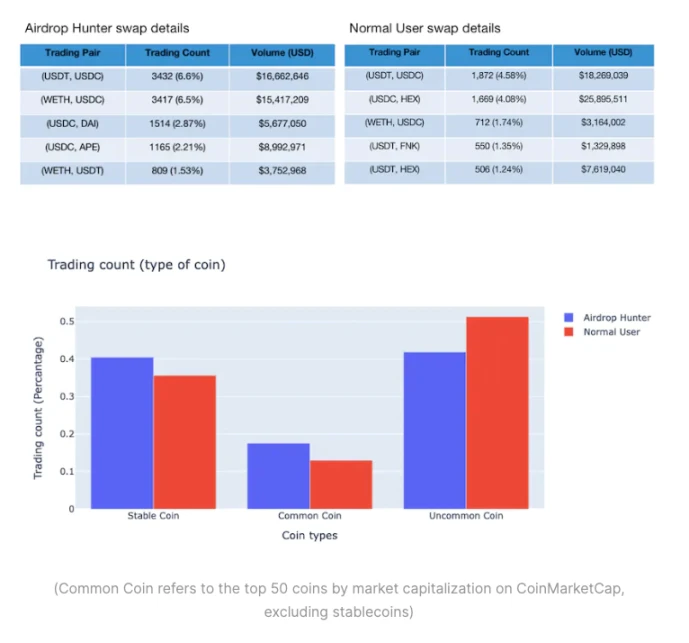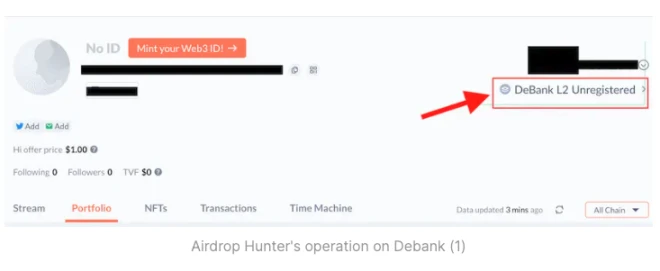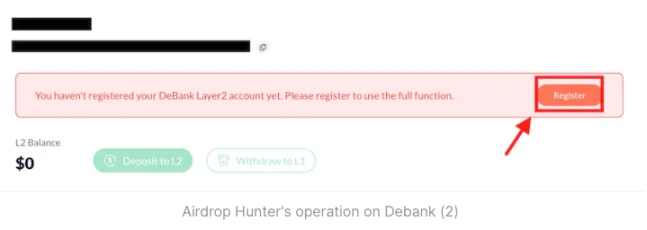- 話題
3596 熱度
90024 熱度
121079 熱度
4298 熱度
1147 熱度
- 置頂
- 🎉 親愛的廣場小夥伴們!【Gate 2025年中社區盛典】內容達人TOP 10更新啦!
行情分析派?幣種研究派?新聞挖掘派?還是活動分享派?風格各異,總有你喜歡的!
⏳ 投票只剩2天,快來爲你心中的達人加油助力!
👉 https://www.gate.com/activities/community-vote
在【廣場】互動就能拿助力值,每30值就能抽一次大獎!
🎁 iPhone 16 Pro Max、金牛雕塑、潮流套裝、合約體驗券等你抱走!
📌 https://www.gate.com/announcements/article/45974 - 🏆 Gate 廣場 #ETH百万矿王争霸赛# 開戰,誰能問鼎百萬礦王寶座?
現在參與 Gate ETH 鏈上挖礦 + 在廣場曬挖礦收益圖,就有機會瓜分 $400 曬圖登榜獎池!
百萬額度質押,穩穩拿 5% 收益 👉 https://www.gate.com/announcements/article/46446
🥇 收益最高曬圖用戶 1 位 * $200 合約體驗券
✨ 優質曬收益用戶 10 位 * $20 合約體驗券每人
📸 參與方式:
1️⃣ 帶話題 #ETH百万矿王争霸赛# 發廣場貼
2️⃣ 曬 Gate ETH 挖礦截圖 + 一句話感言:“我靠 Gate ETH 挖礦賺了 ____,ETH百萬礦王誰敢來挑戰!”
💡 想更容易中獎?可以分享質押教程、挖礦技巧、經驗心得、活動推廣!
⏳ 8月12日 12:00 - 8月16日 24:00(UTC+8)
⛏️ 礦王們,開挖!看看誰才是真正的 ETH 收益之王!
#ETH# - 🚀 以太坊今晨衝上 $4,600,24h 漲幅 +8.69%!
距離歷史高點 $4,891 只差一點,你覺得這波能衝破嗎?
📍 關注 Gate廣場_Official,投票 + 留言理由
🎁 抽 4 位瓜分 $100 合約體驗券! - 還不知道如何參與Gate廣場內容挖礦賺取收益?
速速碼住下圖:內容挖礦參與五部曲 👇️
教你快速掌握賺取最高達 10% 挖礦返佣收益技巧!


深挖空投獵手,是「搭便車」還是優質用戶?
原文作者:X-explore
原文編譯:angelillu,Foresight News
英文原文由X-explore 和WuBlockchain 聯合發表
自2020 年Uniswap 開始使用空投策略獎勵早期用戶以來,空投在Web3 中引發了巨大的熱潮。受此影響,眾多項目中尋找下一個「免費午餐」(尋找新的空投項目)的人數激增。如今,Uniswap 空投已經過去近三年,這段時間許多大型項目紛紛效仿,利用空投來獎勵用戶或吸引關注。據X-explore 估計,今年3 月份Arbitrum 空投中超過20% 的空投被利用Sybil 攻擊的所謂「搭便車」的人拿走了。因此,我們希望通過對多次成功領取空投的用戶進行深度分析,回答以下兩個問題:
為了回答上述問題,我們在眾多的以太坊及其Layer 2 項目中,**精心挑選了5 個「空投領取地址超過10 萬個」、「空投總價值超過1.4 億美元」的項目。 **它們是Uniswap、ENS、Optimism、Blur 和Arbitrum。下文將深入探討這五個項目的用戶,特別關注從這些項目獲得多次空投的「專家」。
注:本文計算幣價的依據是CoinMarketCap 截至2023 年6 月7 日的數據。文中大部分截圖為2023 年6 月14 日,因此價格可能略有不同.
誰是空投獵手?
我們將五個項目中**至少收到三個空投的地址歸類為空投獵手;**收到三到四次空投的人被歸類為標準空投獵手,而收到全部五次空投的人被稱為高級空投獵手。在本次分析中,而我們找到了共34547 個標準空投獵手地址,每個地址的平均空投收入為9384 美元,中位空投收入為6497 美元。至於高級空投獵手,我們總共找到了932 個地址,每個地址的平均空投收入為18935 美元,每個地址的中位空投收入為14288 美元。從平均收入和中位數收入來看,「高級」一詞確實適合高級空投獵手。
X-explore 地址標籤分析
為了更好地揭示空投獵手地址的特徵,我們結合X-explore 專有的鏈上標籤系統,對上述地址從行為、資產、活躍程度、交易盈利等方面進行了深入分析。我們發現,無論是標準空投獵手還是高級空投獵手,他們在去中心化交易所(DEX)和不可替代代幣(NFT)上的交易量都遠遠超過普通用戶。
這些數據表明,空投獵手在加密貨幣市場上比普通用戶更加活躍,表現出更高的數字資產交易熱情,尤其是DEX 和NFT 交易。
以太坊鏈上空投獵手的初始活躍時間
以太坊鏈上空投獵手的活動水平
項目空投後空投獵手的行為
然而Optimism 是個例外:在Optimism 空投之前,OP 鏈上普通用戶的活躍程度實際上已經超過了高級空投獵手。然而,Optimism 空投後,普通用戶的活躍度持續下降。相反,優質空投獵手在收到空投後,OP 鏈上的活躍度呈上升趨勢,在空投後一個月,他們的活躍度超過了普通用戶。通過深入分析,我們發現這主要是OP 空投規則考慮了以太坊上地址的活躍度造成的。結果顯示,許多之前不活躍的優質空投獵手在收到空投後開始對OP 產生興趣,並且開始與OP 鏈上的不同項目積極互動。
總結
在對多個空投獵手地址的詳細鏈上行為進行採樣分析後,我們發現上述分析得到了進一步的佐證。空投獵手的鏈上活動特徵可概括如下:
空投獵手的「下一個目標」是什麼?
在對空投獵手有了一些了解後,他們的「下一個目標」是什麼?他們看好哪些項目?為了回答這個問題,我們研究了他們參與的項目以及他們通過鏈上數據與項目交互時的行為模式。在幫助讀者了解哪些鏈上項目值得交互的同時,進一步揭示了空投獵手與這些項目交互的方法。值得一提的是,我們已將這些空投獵手納入我們的監控系統中。未來,X-explore 將持續關注這些空投獵手的最新動態,為讀者帶來更多有價值的分析。
我們將空投獵手青睞的項目分為幾個賽道,每個賽道按照高級空投獵手的參與率進行排序,並篩選出參與率在25% 以上的項目。如果一個項目有多個智能合約,我們會選擇參與率最高的一個。以下是賽道和項目類別:
加粗、紅圈的項目表示該項目尚未進行空投,也未發行代幣。我們將深入研究空投獵手在這些項目上的行為。
DeFi 賽道:MetaMask、交易路由
經過我們的分析,Metamask 上空投獵手的總交易量為191, 438, 051 美元,**每個空投獵手的交易量的中位數為1255 美元。 **此外,我們從所有1, 811, 782 個Metamask Swap 用戶中刪除了空投獵手,並從這1, 776, 303 個地址中抽取了相同數量的其他Metamask 用戶。我們發現他們在Metamask 上的總交易量為205, 673, 503 美元,交易量中位數為474 美元。儘管總交易量差異並不大,但中位數表明空投獵手之間的交易量更為平均,其中大多數交易量都在1000 美元以上。以下是空投獵手和其他用戶的交易對信息:
我們發現空投獵手對Metamask Swap 和Uniswap 上的交易對有著非常相似的偏好。相比普通用戶,空投獵手更傾向於交易穩定幣和更主流的加密貨幣:USDC、USDT、WETH、DAI、WBTC 等。這些穩定幣和主流加密貨幣具有較高的流動性和相對穩定的價格,降低了交易風險。此外,穩定幣和主流加密貨幣也更容易跨平台轉移和交易,增強了資金的靈活性。這表明空投獵手在追求回報的同時,也注重風險控制和資金的靈活運用。
NFT 賽道:Foundation
我們隨機抽取了三位參與過Foundation 的空投獵手,發現他們在Foundation 的互動並不頻繁。儘管有兩名空投獵手實際上購買了NFT,但大多數互動都是對NFT 進行出價。
Blur 的空投規則可以給我們一些啟示。有些人雖然沒有購買過NFT,但僅僅通過換幣、競價就能獲得可觀的空投收入。所以在和項目交互的時候,我們可以嘗試項目的不同功能,說不定會帶來意想不到的好處。
Layer 2 包圍:zkSync lite、zkSync Era、Starknet
zkSync(lite):我們隨機選擇了4 名已橋接到zkSync lite 的空投獵手,接下來,我們將通過截圖和解釋來引導您了解這些空投獵手在zkSync 上的行為模式。如果您想了解空投獵手的完整行為,請參閱我們附上的鏈接。
空投獵手1 :
第一位空投獵手的第一筆交易發生在2021 年11 月1 日,他從另一個地址轉入了一筆金額。值得注意的是,他隨後的兩次Swap 交易之間的間隔僅為15 秒。他先將ETH 換成USDT,然後又將USDT 換回ETH。這種快速且持續的交易行為看起來像是試圖提高他在zkSync 上的活躍程度。
中間我們省略了幾個跨鍊和地址傳輸操作。空投獵手1 在8 個月前,即2022 年10 月20 日再次進行了類似的交易操作。這次,穩定幣從USDT 切換為USDC,間隔時間約為30 秒。
兩個月前,該地址進行了一系列類似的交易操作(共39 筆交易),每筆交易間隔約20 秒。
空投獵手2 :
第二位空投獵手的行為相對簡單,他於2021 年11 月10 日從主網橋接,並在三個月前進行了第一筆交易(將ETH 兌換為USDC)。然後,該地址有另一筆從主網橋接的交易,此後就沒有其他交易了。
空投獵手3 :
第三位空投獵手在zkSync lite 上的行為與第一位空投獵手非常相似。他們都在2021 年底從主網橋接到zkSync,然後使用zkSync 的Swap 功能將ETH 轉換為穩定幣,然後將穩定幣兌換回ETH(ETH <-> USDT)。而且,他們都進行了多次交易,時間間隔都在20 秒左右。這可能表明他們正試圖通過頻繁交易來增加活動。
忽略中間的幾筆分散的交易,獵手3 在2022 年5 月25 日執行了一組類似的操作,交易時間間隔約為20 秒。
空投獵手4 :
橋接至zkSync lite 後,Hunter 4 進行了一些交易,然後在一段時間後再次橋接。這種行為模式可能意味著他們試圖在zkSync 上維持一定的活動水平,並在需要時進行資金轉移和分配。
zkSync Era:除了zkSync lite 之外,很多空投獵手還選擇通過跨鏈交易在zkSync Era 主網上進行交互。值得注意的是,在zkSync Era 主網上線的前兩天,大量的空投獵手開始交互,表現出他們對zkSync Era 項目的高度興趣和積極參與。
空投獵手1 :
空投獵手1 在zkSync lite 和zkSync Era 上表現出幾乎相同的行為模式。 2023 年3 月24 日zkSync Era 上線後,空投獵手1 第二天就立即橋接至zkSync Era,表現出對這個新項目的高度興趣和快速反應。然後,他使用SyncSwap 合約執行代幣交換操作。
空投獵手1 在初次互動7 天后(2023 年4 月2 日)再次進行了類似的交易行為,以增加活躍度。這個時機非常巧妙,似乎是在不同周提高地址的活躍水平。
空投獵手1 在zkSync Era 上的最後一次操作發生在一個月前(2023 年5 月19 日),本次操作仍然涉及使用SyncSwap 完成ETH 和USDC 之間的兌換操作。
空投獵手2 :
空投獵手2 與空投獵手1 一樣,在zkSync Era 主網上線當天就橋接了zkSync Era,可見其對該項目的高度關注和活躍度。他在zkSync Era 上的多筆交易都是通過Mute 項目進行的。與空投獵手1 在加密貨幣之間進行兌換不同,空投獵手2 通過合約進行了ETH 到ETH 的兌換。這種方式既可以支付較低的費用,避免價格波動的風險,又可以在zkSync 上留下活躍的痕跡。
空投獵手3 :
空投獵手3 和空投獵手1 在同一天(2023 年3 月25 日)橋接到zkSync Era,其鏈上操作與空投獵手1 非常相似。唯一的區別是空投獵手3 使用了SpaceFi 來進行ETH 和USDC 之間交換。
第一次互動一周後(2023 年4 月3 日),空投獵手3 再次在zkSync Era 上進行操作,並使用了的是SyncSwap,而不是SpaceFi。可以看出在提升活躍度的同時,他還參與了zkSync Era 生態內的多個項目。
空投獵手3 之後繼續進行轉賬等活動,還參與了iZUMi 項目,進行了ETH 與ETH 之間的轉賬。值得注意的是, 2023 年5 月15 日該地址有多條轉出記錄。
StarkNet:由於橋接到Starknet 的空投獵手較少,且空投獵手的交易行為模式與zkSync 非常相似,因此我們選擇一個有代表性的地址進行分析和說明。
空投獵手:
Dapp 賽道:DeBank
DeBank 是一個去中心化金融(DeFi)數據分析和資產管理平台,為用戶提供跨不同DeFi 項目的投資和債務的全面視圖。它提供實時項目數據、交易記錄和風險評估,幫助用戶做出明智的投資決策。
最近,DeBank 一直在擴展其DeFi 服務,包括交易功能。社區熱切期待DeBank 的空投。然而,與社區成員按照空投教程使用DeBank 不同,大多數空投獵手只是在DeBank 註冊。他們沒有按照空投教程中的建議使用DeBank 的Swap 功能。下面,我們舉例說明空投獵手如何與DeBank 互動:

從這些優質空投獵手的行為來看,他們似乎更像是在DeBank 註冊以啟用其分析功能,而不是使用DeBank 的Swap 功能來增加潛在空投的機會。
總結
通過對鏈上空投獵手選擇交互的空投項目進行深入分析,我們確定了他們選擇的關鍵驅動因素:
通過對X-explore 的深入分析,我們發現,雖然Arbitrum 和Optimism 上的空投獵手錶現出高質量的交互行為,但在zkSync 和Starknet 上,他們似乎在人為地故意增加交易量和活躍程度。這與鏈上生態系統的完整性密切相關。 Optimism 和Arbitrum 在空投公告之前有一些發展和沈淀時間,而zkSync 在Era 主網上線之前就發布空投信息。這些發現迫使項目團隊重新思考:空投的真正意義是什麼?如何在製定空投規則時識別出真正有價值的用戶,而不是那些只利用空投而進行無意義交互的用戶?
關於空投獵手的看法
**空投獵手主要是真實優質用戶:**他們積極參與各種區塊鏈項目,從事跨鏈交易,並在多個平台上保持一致的活躍度。儘管有關「Sybil 地址」的討論很熱烈,但我們在空投獵手中並沒有發現明顯的「搭便車」行為。相反,他們的行為模式體現了對項目的深度參與和對區塊鏈世界的熱情,而不僅僅是為了短期的空投收益。
**設置空投規則時可以參考成功的例子:**在分析Optimism 上空投獵手的踪跡時,我們發現有很多優質空投獵手因為在以太坊上的活躍而獲得了大量的OP 空投,並最終成為OP 鏈的忠實用戶。因此,項目方在製定空投規則時,可以考慮空投獵手的行為,以確保空投更有效地分發給此類優質用戶。這也有助於項目方利用空投作為激勵機制,提高項目參與度和用戶忠誠度。
**一個好的空投需要滿足兩個核心條件:**合理的空投規則設計和健全的生態系統。在精心設計的空投規則和強大的生態系統下,我們見證了Arbitrum/Optimism 上的優質用戶如何持續保持活躍。但如果在生態尚未完善之前就急於發布空投信息,可能會導致表面繁榮的出現。即使是高質量的空投獵手也可能會在zkSync/Starknet 上進行「故意的助推活動」。